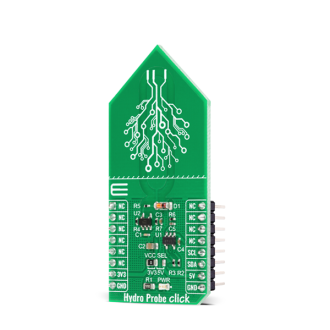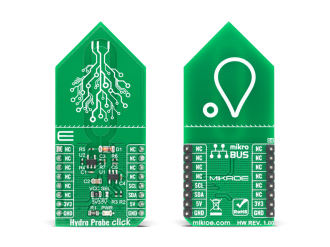
We strongly encourage users to use Package manager for sharing their code on Libstock website, because it boosts your efficiency and leaves the end user with no room for error. [more info]

Rating:
Author: MIKROE
Last Updated: 2020-07-27
Package Version: 1.0.0.0
mikroSDK Library: 1.0.0.0
Category: Environmental
Downloaded: 3405 times
Not followed.
License: MIT license
Hydro Probe Click is a capacitive soil moisture sensor based on capacitive changes that are used to detect the volumetric water content of the soil.
Do you want to subscribe in order to receive notifications regarding "Hydro Probe click" changes.
Do you want to unsubscribe in order to stop receiving notifications regarding "Hydro Probe click" changes.
Do you want to report abuse regarding "Hydro Probe click".


Library Description
The library covers all the necessary functions that enables the usage of the Hydro Probe click board. It offers reading from output register, calulation for average value from 100 raw reads,functions for maximum and mimimum values from 100 raw reads and calculations that result in environment moisture content in percents.
Key functions:
uint8_t hydroprobe_rel_env_hum ( uint16_t dry_val, uint16_t wet_val ); - Function is used to get environment moisture content in percents.uint16_t hydroprobe_min_val ( ); - Function is used to read minimum value from 100 raw reads.uint16_t hydroprobe_max_val ( ); - Function is used to read maximum value from 100 raw reads.Examples description
The application is composed of three sections :
void application_task ( )
{
humy_val = hydroprobe_rel_env_hum( dry_val, wet_val );
WordToStr( humy_val, log_txt );
mikrobus_logWrite( "Environment moisture content: ", _LOG_TEXT );
Ltrim( log_txt );
mikrobus_logWrite( log_txt, _LOG_TEXT );
mikrobus_logWrite( "%", _LOG_LINE );
mikrobus_logWrite( "------------------------------", _LOG_LINE );
Delay_ms( 1000 );
}
Additional Functions :
Other mikroE Libraries used in the example:
Additional notes and informations
Depending on the development board you are using, you may need USB UART click, USB UART 2 click or RS232 click to connect to your PC, for development systems with no UART to USB interface available on the board. The terminal available in all MikroElektronika compilers, or any other terminal application of your choice, can be used to read the message.